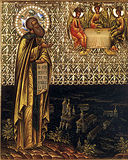

| Previous day | Next day |
| Old Style
March 1
|
Wednesday |
New Style
March 14
|
|
4th Week of Great Lent.
Tone 7.
Great Lent. |
Monastic rule: xerophagy (bread, uncooked fruits and vegetables).
|
![]() Martyr Eudocia of Heliopolis (160-170).
Martyr Eudocia of Heliopolis (160-170).
Martyr Antonina of Nicaea (3rd c.-4th c.). Virgin Domnina, ascetic, near Cyrrhus (450-460). St. Martyrius, founder of Zelenets Monastery (Novgorod) (1603).
New Hieromartyrs Anthony (Korzh), hierodeacon of Kiziltash Monastery (Crimea), Peter Lyubimov, archpriest, of Kishkino (Moscow), and Benjamin Famintsev, archpriest, of Meshcherino (Moscow) (1938). New Martyr Abbess Antonina of Kizliar (1924).
St. Albinus, bishop of Angers (550). St. David of Wales, bishop (6th c.). St. Suitbert (Swidbert), bishop in southern Westphalia and monastic founder on the Rhine River (713). St. Leo-Luke of Corleone, Sicily (ca. 900). St. Agapius of Kolitsou Skete of Vatopedi, Mt. Athos, and his four companions (13th c.). New Martyr Paraskevas of Trebizond (1659).
Thoughts for Each Day of the Year
According to the Daily Church Readings from the Word of God
By St. Theophan the Recluse

Wednesday.
Baptism (kreshenie) in the Russian language sounds like cross (krest). This is fortunate consonance, for although the visible action of baptism is submersion, its essence is a co-crucifixion with Christ on the inner, spiritual cross. The Apostle Paul says: our old man is crucified with him in baptism (Rom. 6:6). This is not some sort of mechanical act, but a moral change, or a revolution of thoughts, goals, desires, and sympathies. Before, all of these were stained with self-pleasure; now all are selflessly dedicated to God, in Christ Jesus, by the grace of the Holy Spirit. [If you were baptized as an infant] you will say, “I didn’t understand that when I was baptized.” Now you understand; set it in your conscience to carry out the meaning of baptism, for your baptism is indelible. Even at the judgement its seal will be visible either for you, or against you.
Articles
 Martyr Antonina of Nicea, in BithyniaAfter fierce tortures, Saint Antonina was thrown into prison, but Maximian could not force the saint to renounce Christ and offer sacrifice to idols. |








